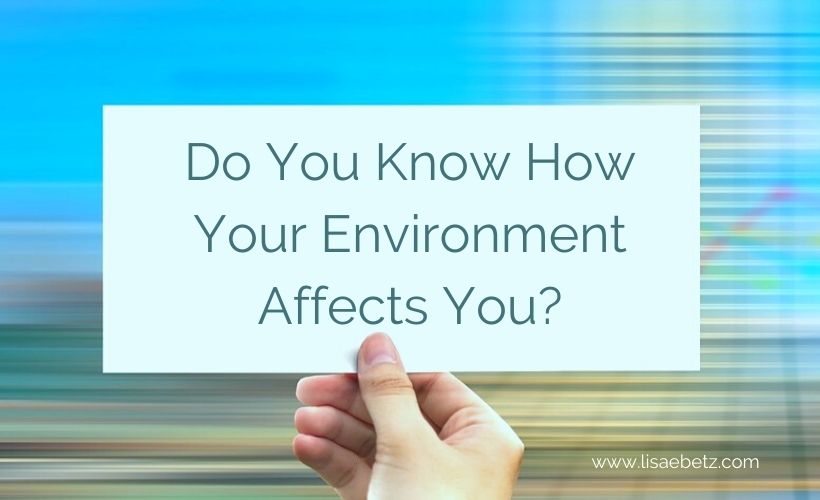How often do you stop to consider how the aspects of your environment are aiding or hindering your productivity? Your health? Your stress level?
How often do you consider how environmental factors affect others in your family or office?
We have varying tolerances toward the many different kinds of environmental stimuli that exist in our world. We tune out some of them without much effort, while others distract us more easily. On top of that, some factors in our environment create stress or cause us to feel unwell, whether we realize it or not.
Do you know how your environment affects you?
Are you intentional about managing your environment to boost your productivity and lower your stress?
An example: Visual stimuli
I’m strongly affected by visual stimuli. I find moving images very distracting. For example:
- TV screens in restaurants. Can I begin to describe how much I HATE this? I want to pay attention to my dinner partners, not have my eyes constantly drawn to some program I don’t care about!
- Animated backgrounds for song lyrics or anything else I’m supposed to read. Can you say motion sickness?
- Auto-play videos on internet ads or social media posts (including gifs). Experts may claim moving images attract attention, but personally video posts are a big disincentive. When I see a moving image on a post, I will immediately scroll past until it disappears!
I don’t have any problem with moving images when my goal is to watch a video. However, when my focus is supposed to be elsewhere, excess visual stimuli is my enemy.
You may not share my issues with visual overstimulation, but many people do. Someone in your family might be among them. And if not, you and your family members are affected by other factors in the list below.
Environmental factors that may be affecting your health and productivity
Visual
Moving images, blinking lights, and busy, cluttered workspaces can be very distracting. Some people need plenty of white space to function at their best.
Noise
Many people (myself included) need quiet to concentrate and de-stress. Some examples of environmental noises that can be annoying or distracting: Websites with background music, TV or radio voices playing in the background, audio notifications on electronic devices, noisy children’s toys, persistent ambient noises like fans or engines, and barking dogs.
Textures
You may not pay them any attention to the texture or softness of something unless you are shopping for a sweater or petting a cat, but for some, textures are an ever-present distraction. Examples include: tags on clothing, rough fabric on furniture, and certain foods with unpleasant textures.
Scents
Our world is filled with odors of all types. Mostly we can ignore them, but I bet any woman who has experienced morning sickness can relate to certain odors affecting them unpleasantly. Some smells, such as perfumes or deodorant sprays, can be overpowering and distracting.
Fumes
On top of exhaust fumes, the manufactured substances that fill our homes outgas various compounds. For example, some people love that “New Car” smell but those outgassing compounds—including ethylbenzene, formaldehyde, and toluene—give me a headache. (Yes, really!)
Other fumes that make me ill include: new paint or carpet fumes, diesel and airplane fumes, and burning candles. Just sitting at an airport gate, breathing whiffs of airplane exhaust makes me vaguely nauseous. Which means when I arrive at my destination, I’m feeling ill. I can’t begin to enjoy my vacation until I’ve had a chance to lie down and calm my stomach. Does someone in your family suffer in a similar fashion? If so, plan recuperation time into your travel plans.
Allergens
These pesky invisible substances can affect our health without warning. Pollen, mold, pet dander, perfumes, and other allergens can severely reduce our productivity and make us feel miserable.
Taste
Did you know that some people have way more taste buds on their tongues than others? Those people are highly sensitive to flavors and are therefor more likely to dislike strong-tasting foods, no matter how often you tell them it’s good for them. We need to acknowledge that there are certain flavors a person simply cannot stand.
Temperature
Some of us run hot. Some of us run cold. This means a certain temperature is comfortable for one person and uncomfortable for another. Do your best to dress appropriately to control your own comfort, but realize that just because you feel hot or cold doesn’t mean others around you feel the same. Additionally, some people’s concentration is significantly affected when they are too hot or too cold, so be aware of this.
Lighting
Some prefer the room to be brightly lit in order to concentrate, while others find bright lights distracting. And some find certain types of lights, such as florescents that flicker at a specific frequency, particularly troublesome.
Emotions
I like to say jokingly that my social empathy radar only gets one bar. In other words, I don’t notice the emotional ambiance in the room. Others can’t help sensing the emotions of everyone around them. They find it difficult to function when there’s a lot of strong emotion buzzing in the air.
The Bottom Line
I hope this helps you become more aware of the many factors in your environment that can either aid or hinder your health, productivity, and stress levels. What kinds of stimuli do you find particularly distracting? What can you do to manage or minimize distractions in your work or home environments? How will you help others manage the environmental factors that affect them?


Definitely the TV on in the background. It’s so distracting!
Yes it is! We avoid restaurants with TVs whenever possible.